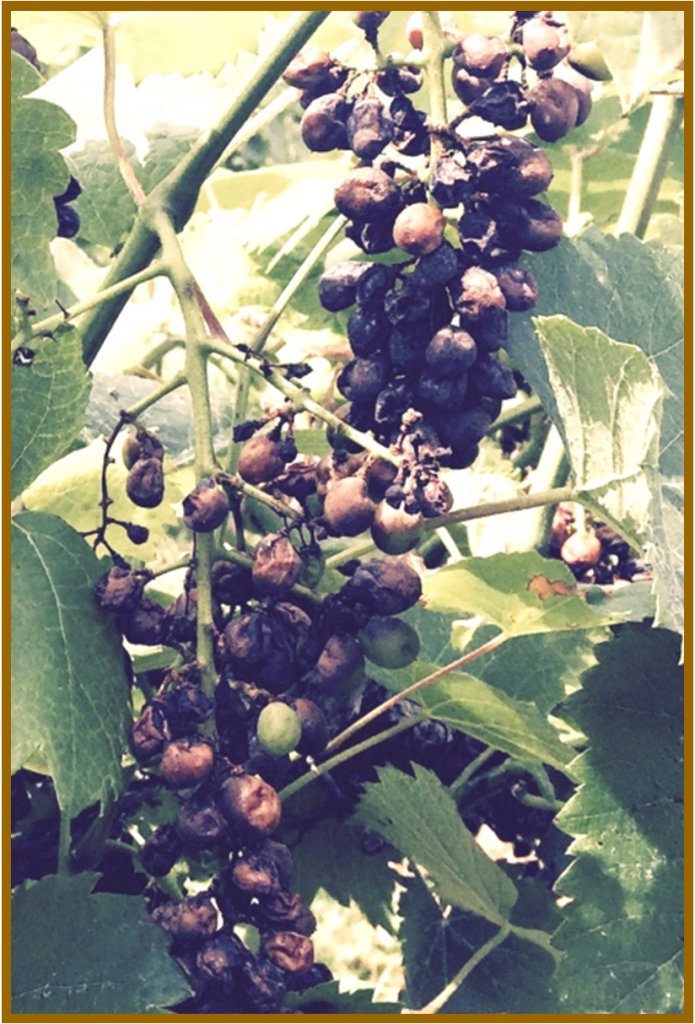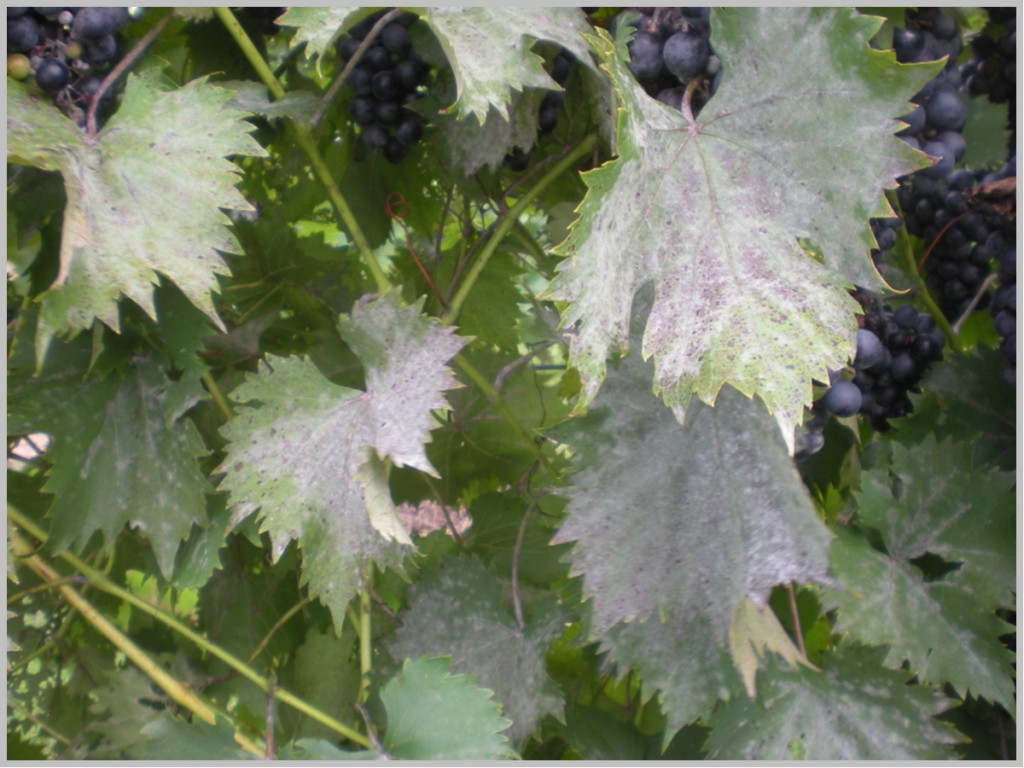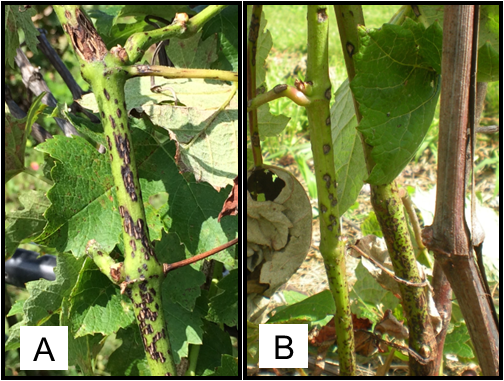Published on
Updated on

Vinews
Viticulture Information News
Week of 10 March, 2025
Columbia, MO
Contents:
- Understand your target fungal pathogens before applying delayed dormant vineyard sprays
- Black rot
- Powdery mildew
- Phomopsis and Anthracnose
- Delayed dormant applications of lime sulfur
- Have a resistance management plan in place for powdery mildew
Understand your target fungal pathogens before applying delayed vineyard sprays
There is value in applying lime sulfur (Sulforix) for managing some grape pathogens prior to bud swell. However, lime sulfur is not a cure all for all pathogens. Lime sulfur has a value for helping manage two specific pathogens. Specifically, Phomopsis cane and leaf spot (Phomopsis viticola) and anthracnose (Elsinoe ampelina). Although lime sulfur will also help manage black rot (Guignardia bidwellii) and powdery mildew (Elsinoe necator) it has limitations based on the biology and ecology of these two pathogens. As grape growers the question becomes where should you spend your time and money in managing these diseases.
Delayed dormant applications of lime sulfur will reduce early season inoculum. Lime sulfur is caustic to overwintering pathogens and in essence burns out the overwintering spores. Since it works as a contact pesticide, application coverage is important.
Black rot
Removing black rot infected material from the vineyard is more important for managing black rot than simply trying to rely on a delayed dormant spray of lime sulfur for early season black rot management (Table 1). Black rot overwinters on canes, tendrils, rachises and mummy berries. During dormant pruning most of the sources of primary black rot inoculum can be removed. The pruning’s should be removed from the vineyard and destroyed. Mummy berries are far and above the primary source of black rot inoculum. Removing the rachises and mummy berries from the vineyard will greatly reduce black rot inoculum.
During the growing season all green tissue is susceptible to black rot infections. A primary infection of Black rot will result in secondary infections. Grape berries develop resistance to black rot infections 5- to 6-weeks after bloom. Protective sprays will need to be applied throughout the season for managing black rot.

Figure 1. Black rot mummy berries are the main inoculum source for infections. Photo credit: D. Volenberg.
Black rot is indigenous to North America thereby it has evolved with many of our native North American grape species. Native grapevines infected with black rot can be a source of black rot inoculum.
Table 1. Sanitation should be part of your early season pathogen control plan.
| Pathogen | Overwintering Site | Sanitation |
|---|---|---|
| Anthracnose | Cane lesions | Remove infected cane wood during dormant pruning |
| Black rot | Rachises/mummy berries | Remove infected rachises and mummy berries during dormant pruning |
| Phomopsis | Cane lesions | Remove infected cane wood during dormant pruning |
Best to remove dormant pruning’s from the vineyard and destroy by fire or burying. All three of the pathogens in Table 1 above require wet green tissue to infect. Infected dormant pruning debris left in the vineyard will produce viable inoculum. This inoculum has the potential to infect green grapevine plant tissue during a rainy and windy weather event.
Powdery mildew

Figure 2. Powdery mildew overwinters as a fungal fruiting body under grapevine bark and in cracks and crevices. Photo credit: D. Volenberg.
Powdery mildew overwinters as a fungal fruiting body (cleistothecia) under the bark and in cracks and crevices of grapevines. The cleistothecia releases ascospores that are the primary inoculum for infection. Ascospores are released with as little as one-tenth of an inch of moisture and temperatures near 50° F. These primary infections result in the production of conidia which results in secondary infections. All green tissue is susceptible to infection by powdery mildew. Developing grapes attain resistance to powdery mildew approximately 5-to 6- weeks after bloom.
Powdery mildew is indigenous to North America. Native grapevines can serve as a reservoir for powdery mildew inoculum. Since powdery mildew cleistothecia are under grapevine bark and in cracks and crevices of the grapevines thorough drenching by lime sulfur applications are needed to have any positive impact for control. Drenching applications are typically not achievable with modern air-blast sprayers or hand-held spray gun application. Areas of the trunks facing the row orientation typically do not receive drenching coverage compared to areas of the trunks facing the row middles limiting lime sulfur efficacy.
Phomopsis and Anthracnose
Both of these pathogens overwinter on the canes of grapevines. In the case of Phomopsis, the overwintering lesions are often found on the first 3 to 4 nodes of infected canes. With spur pruned grapevines many of these infected nodes will remain after dormant pruning. Anthracnose can be managed by removing infected cane wood during dormant pruning. However, like Phomopsis it is very likely that infected canes will remain in spur positions. Since the cane lesions of Phomopsis and Anthracnose are readily accessible to spray coverage lime sulfur can reduce early season inoculum levels. Phomopsis only results in primary infections, but the spore release occurs over an extended period of the growing season. Spores are released from bud break to fruit set at which time spore release in nearly complete. Anthracnose has both primary and secondary inoculum and therefore infections can occur throughout the growing season. Many of the fungicides used during the growing season such as mancozeb and Captan can protect grapevines from anthracnose infections. Most of the cultivars released by Elmer Swenson are susceptible to anthracnose. These include Brianna, St. Peppin, St. Croix, Kay Gray and others.

Figure 3. Phomopsis overwinters as lesions on the basal nodes of canes in photo A. Anthracnose overwinters as lesions on canes in photo B. Photo credits: D. Volenberg
Delayed dormant applications of lime sulfur
Applications of lime sulfur are applied prior to bud swell. Coverage is important but use application volumes to 20 to 30 gallons of carrier per acre to reduce runoff. The best sprayers for application are ones that apply over the top of the cordon or tower sprayers. Air-blast sprayers should be avoided for liquid lime sulfur applications.
The Bottom Line
If you had an issue with Phomopsis or Anthracnose in 2024. Consider applying lime sulfur as a delayed dormant spray application. Focus on removing disease infected material out of the vineyard and sanitation. Realizing that your disease management program during the growing season will have you protecting your vines from Anthracnose, Black rot, Phomopsis and Powdery mildew.
Have a resistance management plan in place in place for powdery mildew
Resistance to DMI fungicides-sterol biosynthesis inhibitors (FRAC 3) was confirmed in Boone County, MO in 2021. Most all labels of FRAC 3 fungicides limit applications to 2 applications per growing season. In Table 2 and 3 below are mixed group fungicides and single group fungicides for managing powdery mildew. If you eliminate all FRAC code 3 fungicides this eliminates 10 fungicide products. That does not mean that these products are not effective at controlling powdery mildew in your vineyard. More likely these fungicide products are effective, but you should consider applying no more than two applications per growing season. Also rotate fungicides from different FRAC codes to reduce the potential of selecting fungicide resistant powdery mildew strains. As a cautionary warning, powdery mildew has developed resistance to FRAC 3, 7 and 11 in Oregon state. If that occurs in Missouri, we would only have 6 fungicides available for managing powdery mildew. Be good stewards and have a resistance management plan in place.
Table 2. Mixed group fungicides and their effectiveness in protecting against powdery mildew.
| Product1 | Active ingredient | FRAC | PHI | Effectiveness |
|---|---|---|---|---|
| Aprovia Top | difenoconazole + benzovindiflupry | 3+7 | 21 | Good |
| Fervent | isofetamid + tebuconazole | 3+7 | 14 | Excellent |
| Inspire Super | cyprodinil + difenoconazole | 3+9 | 14 | Good |
| Luna Experience | fluopyram + tebuconazole | 3+7 | 45 | Good |
| Luna Sensation | fluopyram + trifloxystrobin | 7+11 | 14 | Good |
| Merivon | fluxapyroxad + pyraclostrobin | 7+11 | 14 | Good to Excellent |
| Meravis Prime | pydiflumetofen + fludioxonil | 7+12 | 14 | Good |
| Pristine | bosclid + pyraclostrobin | 7+11 | 14 | Good |
| Quadris Top | azoxystrobin + difenoconazole | 3+11 | 14 | Good |
| Revus Top | Mandipropamid + difenoconazole | 3+40 | 14 | Excellent |
| Topgaurd | azoxystrobin + flutriafol | 3+11 | 14 | Good |
1All products are registered for use in Missouri.
Table 3. Single group fungicides and their effectiveness in protecting against powdery mildew.
| Product1 | Active ingredient | FRAC | PHI | Effectiveness |
|---|---|---|---|---|
| Abound | azoxystrobin | 11 | 14 | Good |
| Aprovia | benzovindiflupyr | 7 | 21 | Good to Excellent |
| Cevya | mefentrifluconazole | 3 | 14 | Good to Excellent |
| Endura | boscalid | 7 | 14 | Good to Excellent |
| Flint Extra | trifloxystrobin | 11 | 14 | Good |
| Kenja | isofetamid | 7 | 14 | Good to Excellent |
| Prolivo | pyriofenone | 50 | 0 | Excellent |
| Quintec | quinoxyfen | 13 | 21 | Excellent |
| Rally | myclobutanil | 3 | 14 | Good |
| Regev | difenoconazole +tea tree oil | 3+BM01 | 2 | Fair to Good |
| Rhyme | flutrafol | 3 | 14 | Good |
| Sulfur | Microthiol disperss | M2 | 0 | Good to Excellent |
| Tebustar 45 WSP | teboconazole | 3 | 14 | Fair to Good |
| Topsin M | thiophanate methyl | 1 | 7 | Excellent |
| Vivando | metrafenone | U8 | 14 | Excellent |
1All products are registered for use in Missouri.
Please scout your vineyards on a regularly scheduled basis in an effort to manage problem pests. This report contains information on scouting reports from specific locations and may not reflect pest problems in your vineyard. If you would like more information on IPM in grapes, please contact Dean Volenberg at 573-882-0476 (office) 573-473-0374 (mobile) or volenbergd@missouri.edu